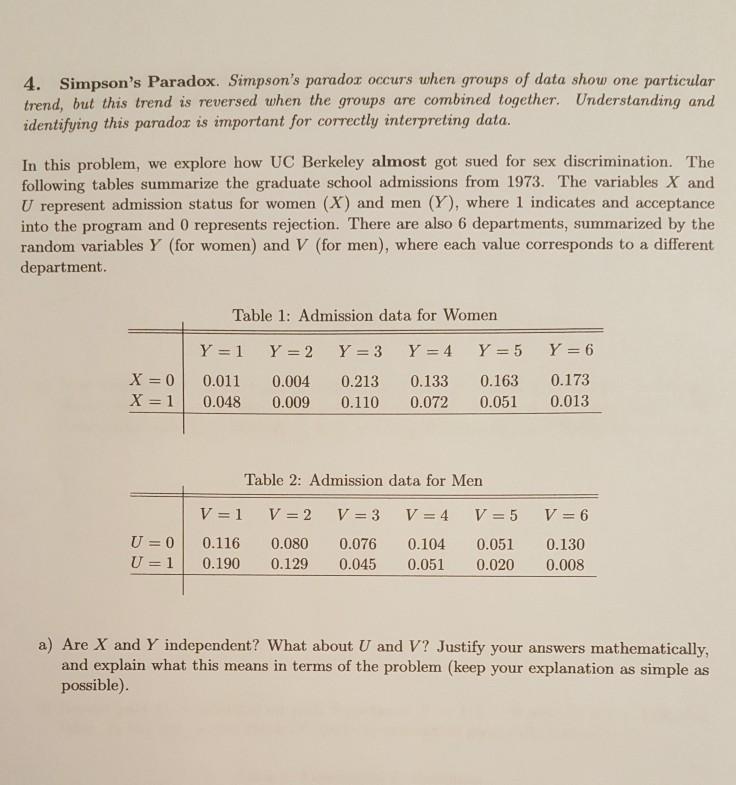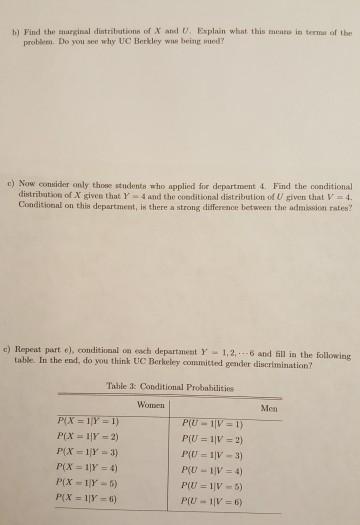Answered step by step
Verified Expert Solution
Question
1 Approved Answer
4. Simpson's Paradox. Simpson's parador occurs when groups of data shouw one particular trend, but this trend is reversed when the groups are combined


4. Simpson's Paradox. Simpson's parador occurs when groups of data shouw one particular trend, but this trend is reversed when the groups are combined together. Understanding and identifying this paradox is important for correctly interpreting data. In this problem, we explore how UC Berkeley almost got sued for sex discrimination. The following tables summarize the graduate school admissions from 1973. The variables X and U represent admission status for women (X) and men (Y), where 1 indicates and acceptance into the program and 0 represents rejection. There are also 6 departments, summarized by the random variables Y (for women) and V (for men), where each value corresponds to a different department. Table 1: Admission data for Women Y = 1 Y = 2 Y = 3 Y = 4 Y = 5 Y = 6 X = 0 X = 1 0.011 0.004 0.213 0.133 0.163 0.173 0.048 0.009 0.110 0.072 0.051 0.013 Table 2: Admission data for Men V = 1 V = 2 V = 3 V = 4 V = 5 V = 6 U = 0 U = 1 0.116 0.080 0.076 0.104 0.051 0.130 0.190 0.129 0.045 0.051 0.020 0.008 a) Are X and Y independent? What about U and V? Justify your answers mathematically, and explain what this means in terms of the problem (keep your explanation as simple as possible). b) Find the narginal dintributions of X and U. Explain what this meato in terma of the problem. Do you see why UC Berkley we being mued? c) Now consider only those studenta who applied for department 4. Find the conditional distribution of X given that Y 4 and the conditional distribution of U given that V=4. Conditional on this department, is there a strong differenoe between the admission rates c) Repeat part e), conditional on each departament Y-1,2,6 and fill in the following table. In the end, do you think UC Berkeley committed gender dliscrimination? Table k Conditional Probahilities Women Men P(X = 1Y = 1) PU-1V = 1) P(U = 1|V = 2) P(U - 1|V -3) P(U - V = 4) P(X = 1{Y = 2 P(X =1Y = 3) P(X = 1|Y = 4) P(X - 1Y-5) PU = 1|V -5) P(U - 1V = 6) P(X = 1|Y =6)
Step by Step Solution
★★★★★
3.46 Rating (156 Votes )
There are 3 Steps involved in it
Step: 1
Above table indicates the graduate school admission There are two tables one for women and the other ...
Get Instant Access to Expert-Tailored Solutions
See step-by-step solutions with expert insights and AI powered tools for academic success
Step: 2

Step: 3

Ace Your Homework with AI
Get the answers you need in no time with our AI-driven, step-by-step assistance
Get Started


